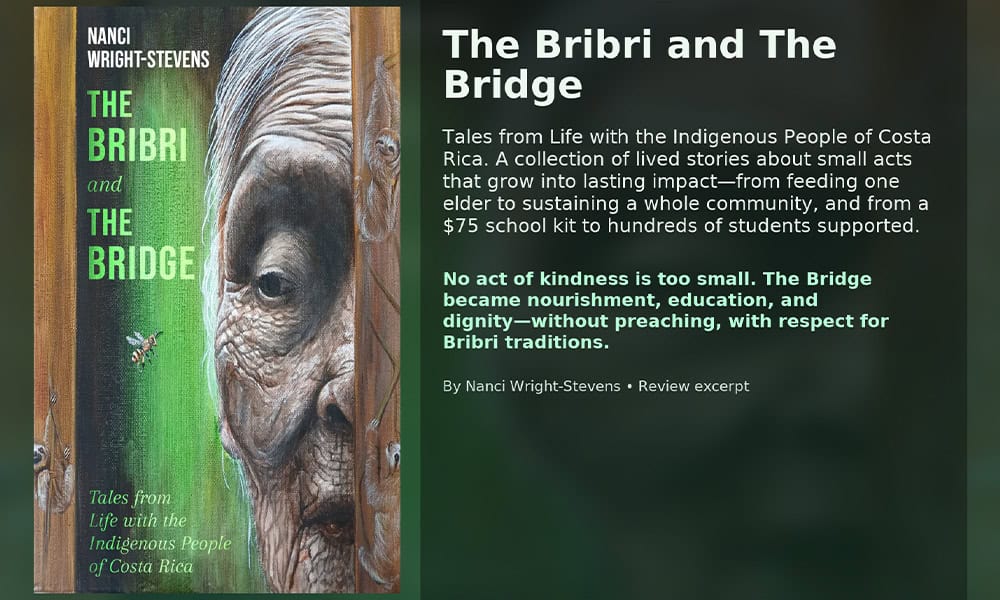The book The Bribri and The Bridge: Tales from Life with the Indigenous People of Costa Rica is both a celebration and a portrait of compassion’s enduring impact, revealing how it shapes the lives of those who extend it and those who receive it.
When Nanci Wright-Stevens and her husband Barry left the United States to enjoy a retired life abroad in the Costa Rican jungle, they didn’t know life was leading them into a life-changing journey. By responding to hunger, poverty, and isolation in their adopted community, they transformed not only their own lives but also those of countless others.
At its heart, the book is a love letter to the often messy but deeply rewarding work of building bridges, deep human connections across cultures.
The book is not a linear narrative but a collection of stories; a compilation of memories that deeply moved the author. Yet, it does not romanticize Indigenous life, or life in general. It acknowledges social problems head-on: poverty, violence, lack of access to medicine, and the destructive pull of alcoholism. Many families lived on less than $2 a day. Children suffered from parasites, skin diseases, and infections that could have been easily treated elsewhere.
A recurring lesson is that no act of kindness is too small. Feeding Paco, an elderly man who scavenged for food in dumpsters, grew into a soup kitchen that sustained a whole community. Sponsoring Alejandro, a boy who needed just $75 for school uniforms and supplies, sparked an educational program that eventually supported 330 students in a single year. Over time, The Bridge evolved into a place of nourishment, education, and dignity, drawing volunteers from around the globe.
Ultimately, The Bribri and The Bridge is not a book of miracles. It does not pretend that poverty was solved, or that every story ends happily. What it offers instead is something both humbler and more profound: a vision of how small acts of service accumulate into lasting impact.
The author also explores religion with nuance. Wright-Stevens and her husband are clear that The Bridge is a faith-based, non-denominational nonprofit. Yet what set their work apart was the ethos they lived by: “We did not believe it was fair practice to preach to hungry people.”
While holding their own beliefs, the couple also shows deep respect for Indigenous spiritual traditions. The author avoided the savior complex that often shadows cross-cultural aid work. Neither of them is presented as heroes.
Instead, they share stories of connection, with elders like Faustina, who lived nearly a century without knowing the world was round; with laborers like Constantino, who discovered spiritual wisdom through borrowed books; and with children like Carmelita, who discovered skin color.
Wright-Stevens writes with warmth and humility, sharing what she lived. While she doesn’t cut back on the hardships of life, she also presents a slapstick scene of Barry attempting to “rescue” a crab, only to end up in comic disaster, or her own personal experience with being in the line of fire of a howler monkey which pelted her with a well-aimed piece of excrement.
Some stories feel like brief sketches that could have been developed further, but that seems intentional. These moments are captured as they happened: unpolished, reflecting the immediacy of real life. Humor, hardship, and introspection coexist, just as they do in everyone’s lives. Wright-Stevens conveys the authenticity of her experience.
The book leaves readers with a strong sense of hope, tinged with a bittersweet awareness. In a world often marked by division and uncertainty, her book feels more relevant than ever. It stirs the conscience, reminding readers that no matter where life takes them, everyone holds the power to build bridges.
The Bribri and The Bridge: Tales from Life with the Indigenous People of Costa Rica is available for purchase from Lulu and a Ebook version on Amazon.; 20% of the profits from book sales go directly to The Bridge.







